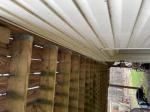Waterproofing top of joists
by Bill
(London, ON)
Twenty-one years ago I built a cedar deck. This year I'm replacing all the horizontal wood (I left it to the elements for all this time, but now the horizontal wood has worn out).
In order to screw deck boards from below (the deck is high enough for me to work under it) I nailed a 1X4 board on top of the joist and screwed the boards from below on both sides (I guess using 1x3s and securing boards on just one side would work as well). Twenty-one years ago, I just used cedar 1x4s, but I noticed that some of them have rotted away.
So, this time I'm looking for ways to waterproof the 1x4s before I put the decking boards on top of them. Would something like Black Knight Roof Sealer work? Or what about Blue Seal Waterproof Rubber Membrane? Or perhaps tar paper is a better choice? Looking forward to your comments!
Editor's Comments
The problem of deck boards or the joists below rotting can be more severe in some parts of the country than others. Certainly in more humid areas with frequent rain there will be a greater chance of rot taking hold between the gaps of the boards over the joists.
If you used 1x4 over top each joist in order to screw the boards from underneath you may have increased the chances of rot starting because instead of 1.5" long joist surface for rain and debris to settle on, it was increased to 3.5" or 4".
However, getting twenty one years of use out of your deck is beyond the average in North America.
Sealants
You mentioned using two different kinds of water sealing compounds. A sealant that is painted on may work but I would shy away from that and go with something like an actual stripped membrane. Something that is only 2" wide. Grace Ice and Watershield is one idea or something from Blueskin is another.
Caps
Alternatively there is a cap system called Rot-Not that seems to go directly after this problem.
Felt Paper
And of course a good heavy 15lb felt paper has always been shown to work quite well. Although you have to staple it down or apply a roofing sealant on the edge of the joist and lay it over top. Stapling is easier.
Joist Clips
Lastly you could use a joist spacer that is domed and sheds the water and debris and locks permanently under each deck board.
At any rate, if you use one of the above solutions you should expect more than another twenty-one years of longevity from the deck. That makes at least forty-two years of service for two decks. Impressive.
Comments for Waterproofing top of joists
|
||
|
||



























